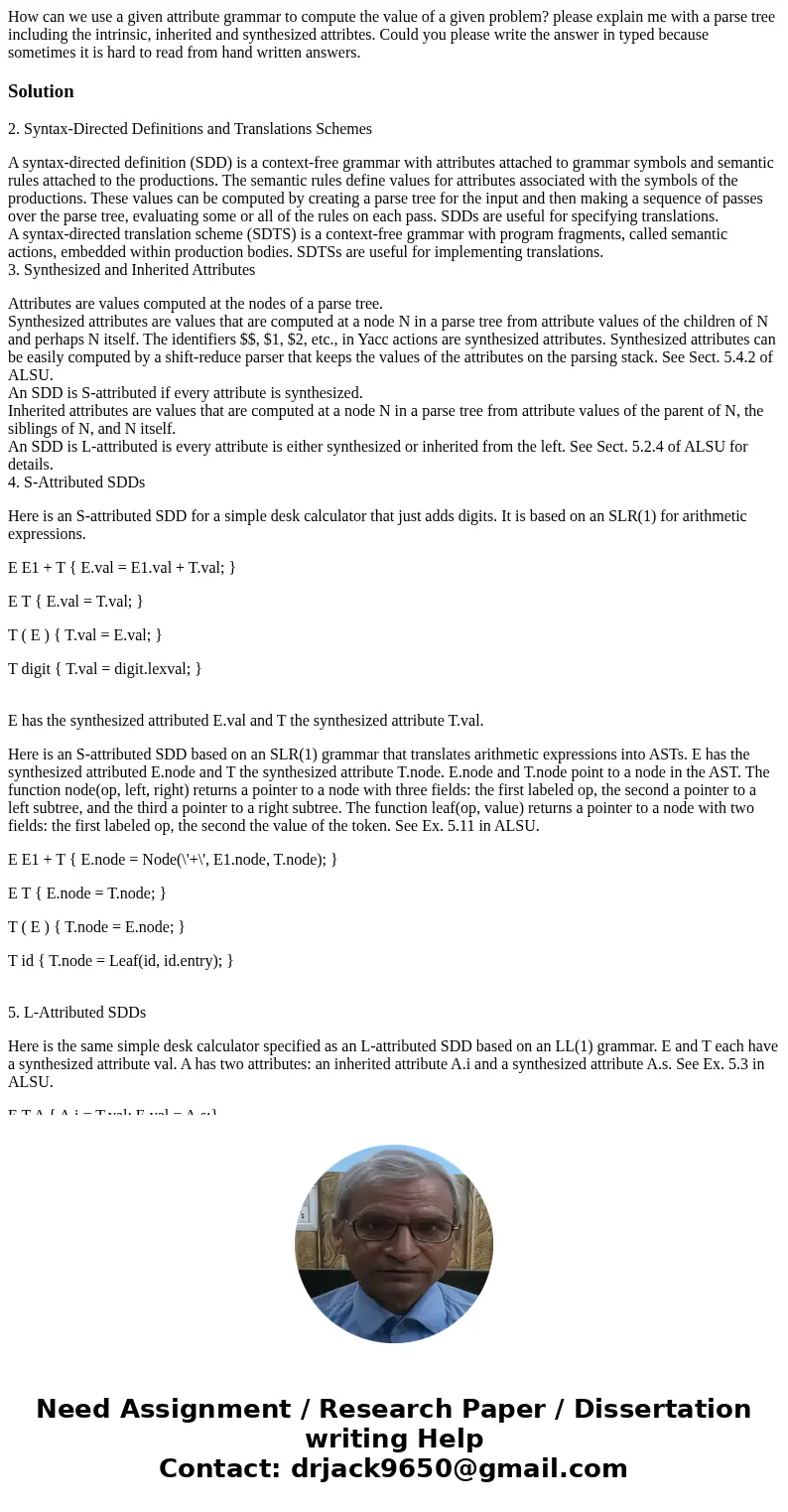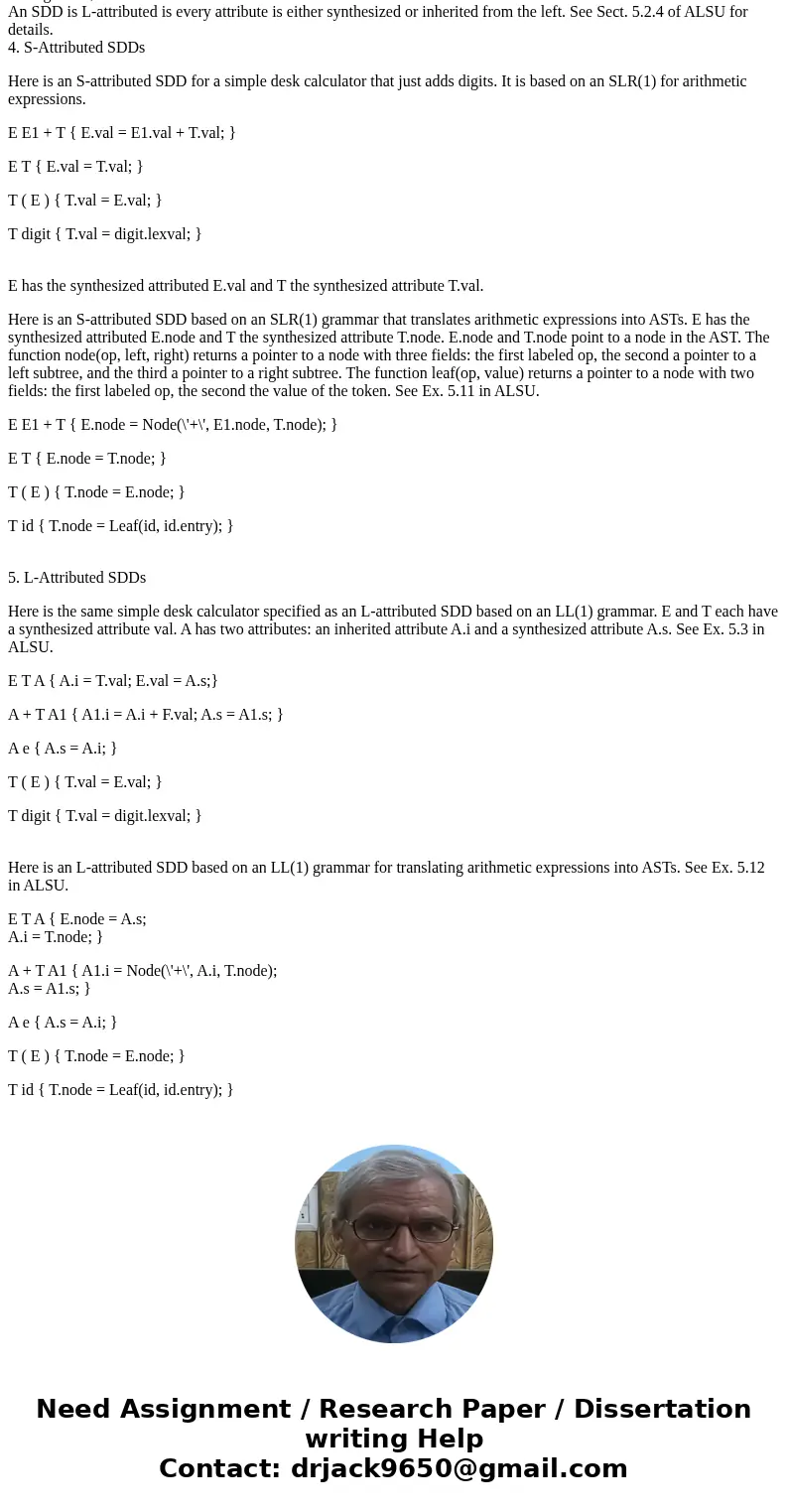How can we use a given attribute grammar to compute the valu
How can we use a given attribute grammar to compute the value of a given problem? please explain me with a parse tree including the intrinsic, inherited and synthesized attribtes. Could you please write the answer in typed because sometimes it is hard to read from hand written answers.
Solution
2. Syntax-Directed Definitions and Translations Schemes
A syntax-directed definition (SDD) is a context-free grammar with attributes attached to grammar symbols and semantic rules attached to the productions. The semantic rules define values for attributes associated with the symbols of the productions. These values can be computed by creating a parse tree for the input and then making a sequence of passes over the parse tree, evaluating some or all of the rules on each pass. SDDs are useful for specifying translations.
A syntax-directed translation scheme (SDTS) is a context-free grammar with program fragments, called semantic actions, embedded within production bodies. SDTSs are useful for implementing translations.
3. Synthesized and Inherited Attributes
Attributes are values computed at the nodes of a parse tree.
Synthesized attributes are values that are computed at a node N in a parse tree from attribute values of the children of N and perhaps N itself. The identifiers $$, $1, $2, etc., in Yacc actions are synthesized attributes. Synthesized attributes can be easily computed by a shift-reduce parser that keeps the values of the attributes on the parsing stack. See Sect. 5.4.2 of ALSU.
An SDD is S-attributed if every attribute is synthesized.
Inherited attributes are values that are computed at a node N in a parse tree from attribute values of the parent of N, the siblings of N, and N itself.
An SDD is L-attributed is every attribute is either synthesized or inherited from the left. See Sect. 5.2.4 of ALSU for details.
4. S-Attributed SDDs
Here is an S-attributed SDD for a simple desk calculator that just adds digits. It is based on an SLR(1) for arithmetic expressions.
E E1 + T { E.val = E1.val + T.val; }
E T { E.val = T.val; }
T ( E ) { T.val = E.val; }
T digit { T.val = digit.lexval; }
E has the synthesized attributed E.val and T the synthesized attribute T.val.
Here is an S-attributed SDD based on an SLR(1) grammar that translates arithmetic expressions into ASTs. E has the synthesized attributed E.node and T the synthesized attribute T.node. E.node and T.node point to a node in the AST. The function node(op, left, right) returns a pointer to a node with three fields: the first labeled op, the second a pointer to a left subtree, and the third a pointer to a right subtree. The function leaf(op, value) returns a pointer to a node with two fields: the first labeled op, the second the value of the token. See Ex. 5.11 in ALSU.
E E1 + T { E.node = Node(\'+\', E1.node, T.node); }
E T { E.node = T.node; }
T ( E ) { T.node = E.node; }
T id { T.node = Leaf(id, id.entry); }
5. L-Attributed SDDs
Here is the same simple desk calculator specified as an L-attributed SDD based on an LL(1) grammar. E and T each have a synthesized attribute val. A has two attributes: an inherited attribute A.i and a synthesized attribute A.s. See Ex. 5.3 in ALSU.
E T A { A.i = T.val; E.val = A.s;}
A + T A1 { A1.i = A.i + F.val; A.s = A1.s; }
A e { A.s = A.i; }
T ( E ) { T.val = E.val; }
T digit { T.val = digit.lexval; }
Here is an L-attributed SDD based on an LL(1) grammar for translating arithmetic expressions into ASTs. See Ex. 5.12 in ALSU.
E T A { E.node = A.s;
A.i = T.node; }
A + T A1 { A1.i = Node(\'+\', A.i, T.node);
A.s = A1.s; }
A e { A.s = A.i; }
T ( E ) { T.node = E.node; }
T id { T.node = Leaf(id, id.entry); }


 Homework Sourse
Homework Sourse